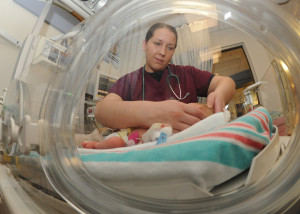During the years 1999-2013, the amount of prescription opioids dispensed in the United States nearly quadrupled, and since 2000, it is estimated that opioid use during pregnancy has tripled. Notably, the tragic consequences of the extreme availability of such drugs include abuse, physical dependence, and increasingly, death through inadvertent overdose.
 In addition, for the individual pregnant woman, a minimum of two lives is affected: her own and that of her unborn child. The prevalence of prenatally exposed newborns to one or more illicit drugs approximates 6%. Neonatal Abstinence Syndrome (NAS) refers to the withdrawal symptoms from physical dependence experienced by the newborn exposed during pregnancy generally to illicit drugs, prescribed drugs, or to those opioids employed in medication-assisted treatment of maternal opioid addiction.
In addition, for the individual pregnant woman, a minimum of two lives is affected: her own and that of her unborn child. The prevalence of prenatally exposed newborns to one or more illicit drugs approximates 6%. Neonatal Abstinence Syndrome (NAS) refers to the withdrawal symptoms from physical dependence experienced by the newborn exposed during pregnancy generally to illicit drugs, prescribed drugs, or to those opioids employed in medication-assisted treatment of maternal opioid addiction.
Withdrawal symptoms can vary markedly in terms of time of onset and severity but typically manifest as tremulousness, agitation, sleeplessness, and poor feeding. NAS increased threefold from 2000-2009 and frequently requires prolonged newborn hospitalization. It has been reported that aggregate hospital charges for NAS increased from 732 million dollars to 1.5 billion dollars with approximately 80% attributed to state Medicaid programs in 2012. Clearly, NAS is a costly public health problem resulting in significant human suffering and expense.
Traditionally, infants who are known to be at risk for NAS have been monitored in the postpartum unit after birth for at least 96 hours and withdrawal symptoms scored based on the Finnegan Scale developed in the mid 1970’s. Typically, if the scores exceed certain values, the newborn is admitted to a Special Care Unit where pharmacologic treatment is frequently started. As withdrawal symptoms subside, dosing is gradually tapered and ultimately stopped. The newborn is observed off medication and monitored for recurrence of disabling withdrawal symptoms. The entire process can generally result in a prolonged Special Care Unit hospital stay of 2-10 weeks.
With the seemingly overnight explosion in the number of newborns demonstrating withdrawal symptoms in the early 2000’s, medical caregivers and hospitals were caught off-guard. On short notice, staff addiction education, medication and weaning protocols, general care policies, and hospital space allocation were required. After a number of years of concerted, collaborative work, much has been learned and achieved in improving the care of the substance-exposed infant.
Nevertheless, pharmacologic treatment continues to require prolonged hospital stays, often in costly Special Care Units. In addition, it effectively excludes full participation by the eventual sole primary caregivers, ideally the parents. It is with these disturbing issues in mind that it is refreshing to note the work and studies over the past several years to further optimize the care provided to infants with NAS and their families.
One of the earlier studies to suggest the therapeutic benefits of a different approach to caring for the drug-exposed infant was that of Abrahams et al. published in the Canadian Family Physician in 2007. During the same period of frenzy involving inpatient hospital transfers, guaranteeing interobserver scoring reliability, pharmacologic treatment protocols, and nursing care directives, the Canadian group with extensive previous experience in addiction medicine reported in a retrospective cohort study the benefits of a rooming-in policy whereby infants remained with their mothers as primary caretakers.
They noted that infants who roomed-in were less likely to require pharmacologic therapy for withdrawal and more likely to be discharged to mother’s care compared to infant’s who received standard nursery care. Subsequently, other retrospective cohort studies both in Europe and the United States demonstrated equally beneficial effects of rooming-in regarding decreased requirement for pharmacologic therapy and decreased duration of hospital stay.
Most recently, the results of a quality collaborative project from the Children’s Hospital at Dartmouth Hitchcock were described in the May, 2016 Pediatrics and demonstrated the beneficial effects of combined standardized protocols and family-centered care in the management of the drug-exposed infant. Over time, the project safely reduced the number of infants requiring pharmacologic therapy, average length of stay, and overall hospital costs.
Among others, key drivers to success were prenatal education of family caregivers including expressed expectation that they would provide meaningful rooming-in care, baby-centered NAS scoring including on demand feeding schedules, pharmacologic therapy when necessary with dosing adjustment based on overall infant condition rather than solely Finnegan score and determined by a consistent team, and an infant “snuggler” volunteer program to assist families when times required their absence.
Overall, the project demonstrated that despite many practical obstacles to providing high quality care for drug-exposed newborns and their families in the hospital setting, where there’s a will, there’s a way.






